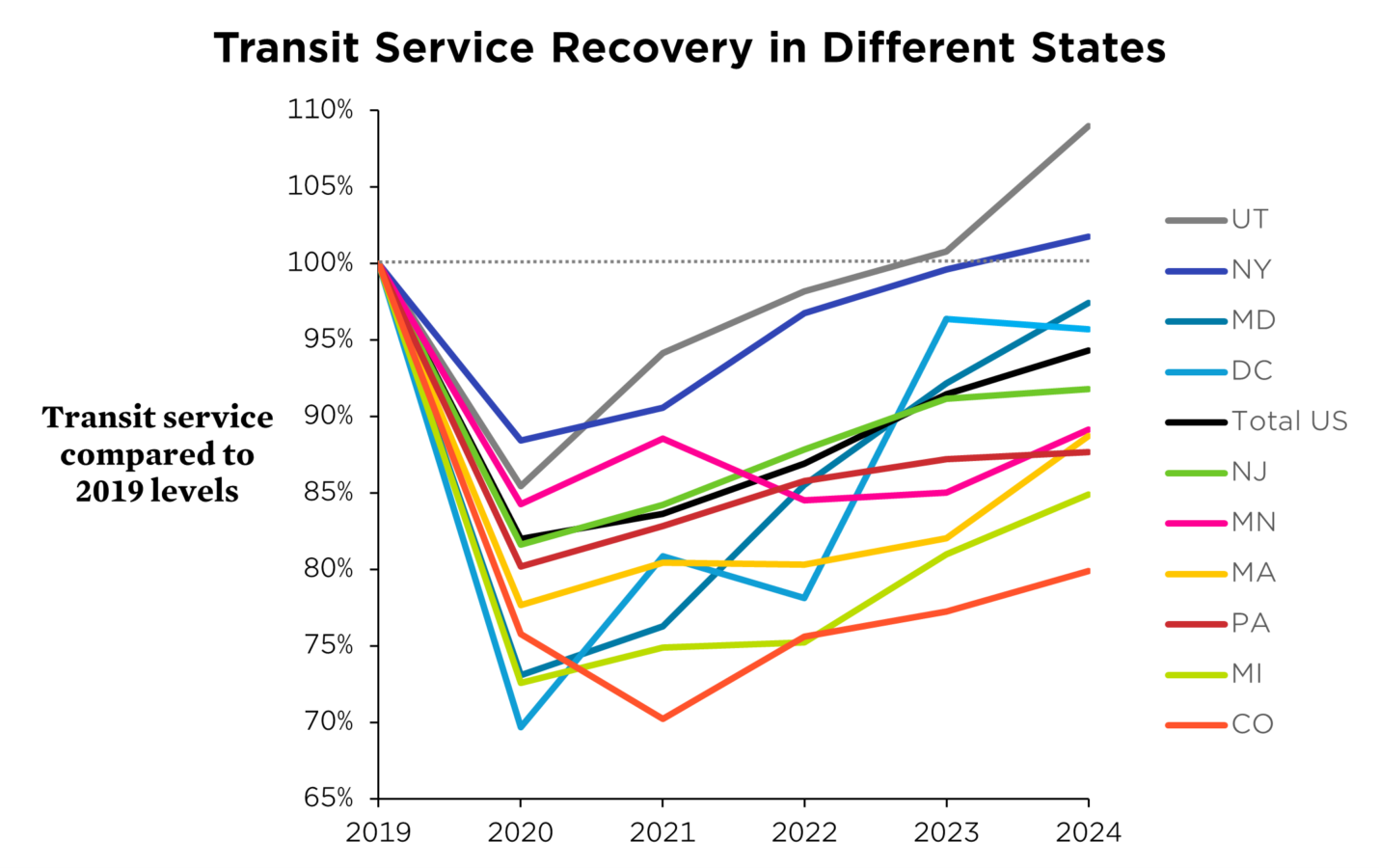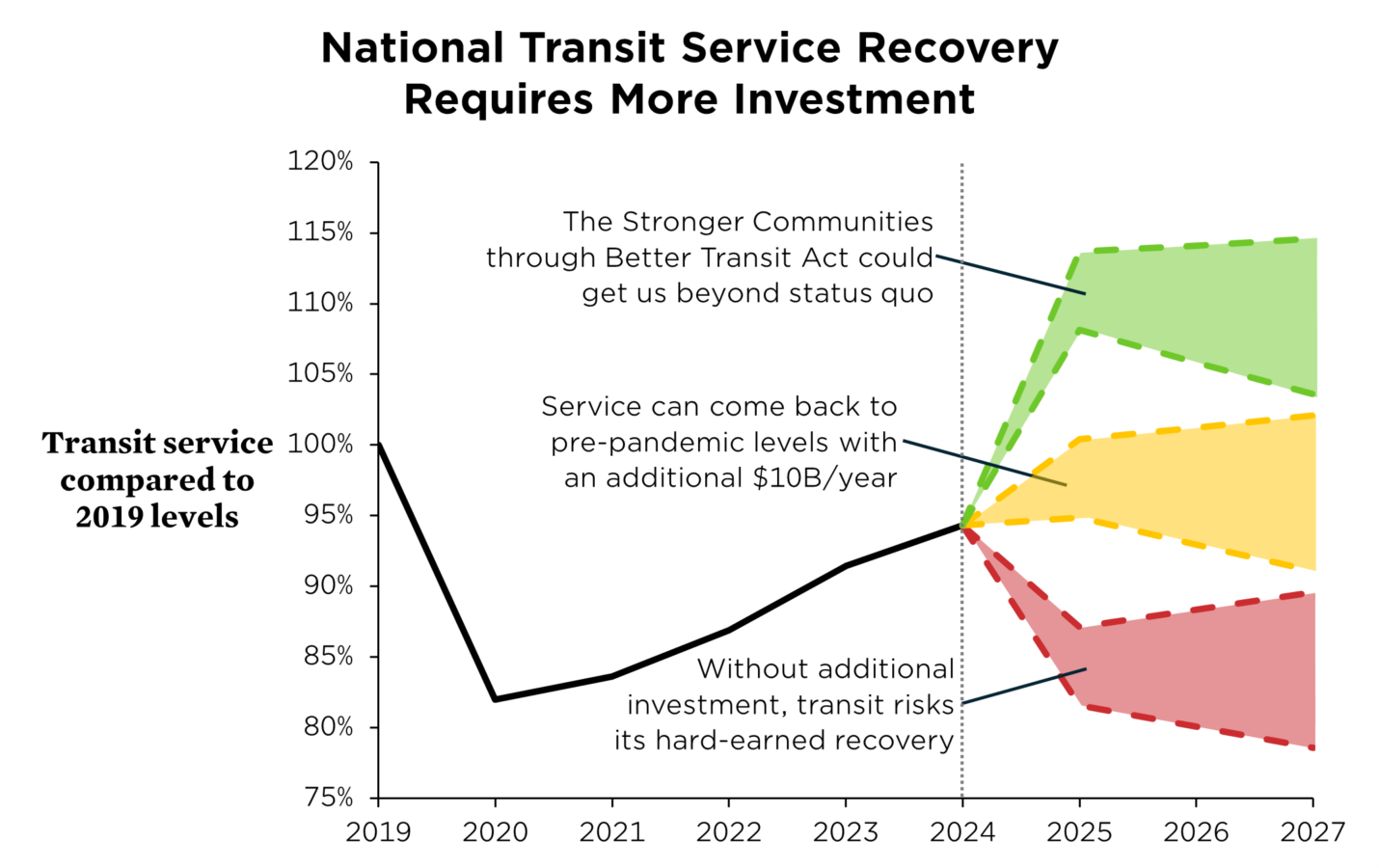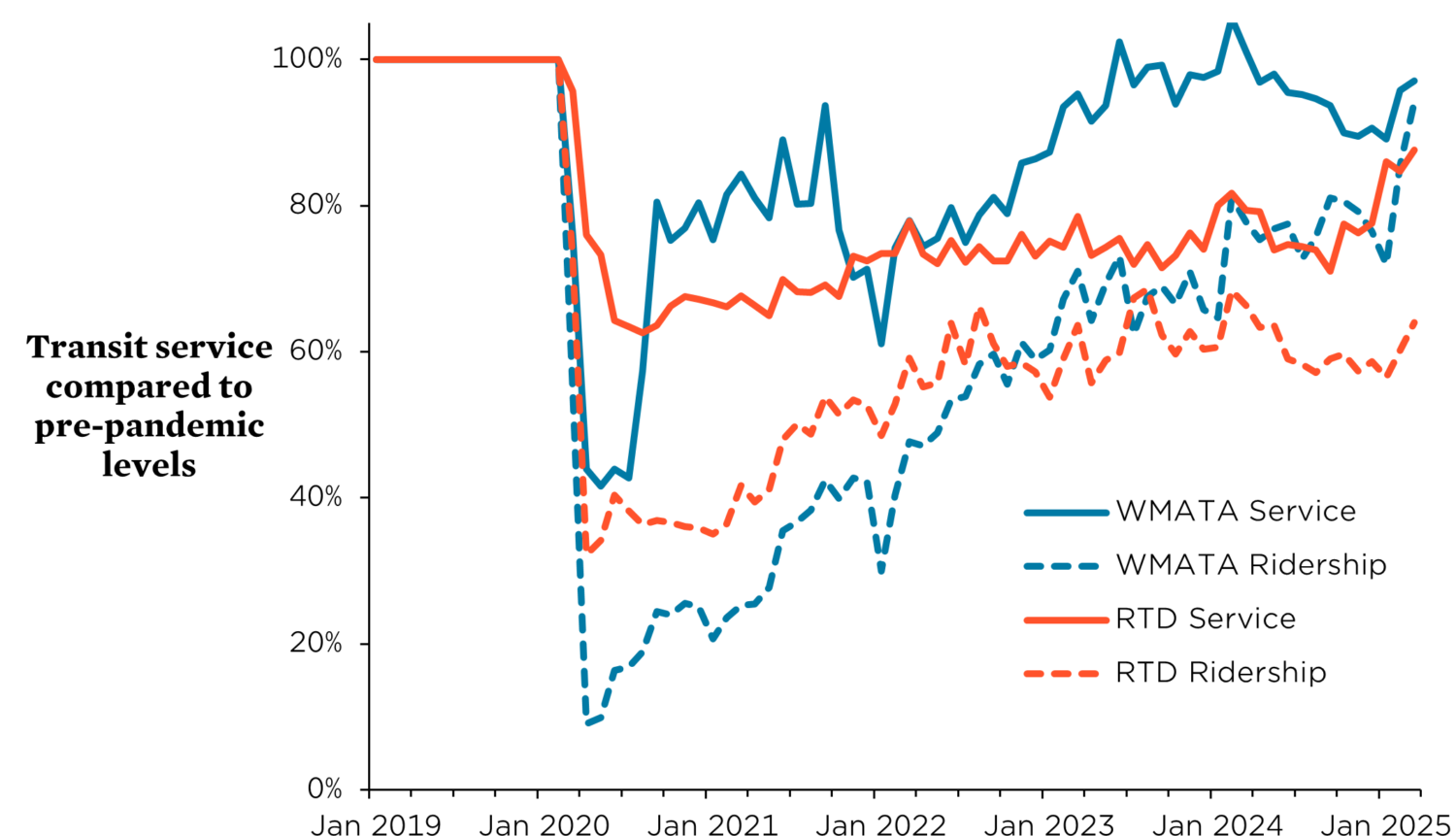Transit is essential for the climate, our health, and our pocketbooks, but was never set up for success in transportation policy. While transit agencies in the United States have made slight increases in the amount of buses and trains they run, this has been insufficient to meet the growing demand for more transportation options.
Even status quo levels of transit are far from the future of abundant transportation options needed to truly address global warming emissions, high car ownership costs, and an inequitable status quo. Newly updated numbers from the Center for Neighborhood Technology’s AllTransit tool show that:
- 52% of the US population does not live within walking distance (1/2 mile) of transit
- 86% … to high-frequency rush hour transit (defined here)
- 91% … to high-frequency full day transit
- 96% … to high-frequency around the clock transit
That’s right, over half of the country’s population does not live near any transit. Many fewer people live near quality transit that runs every 15 minutes or less. In other words, most people in the US do not have many options in getting where they need to go. And UCS estimates that without $10 billion in 2025 to get back to normal, it could get worse—the country stands to risk up to 20% of its transit service.
The pandemic exposed and deepened decades-long disinvestment in transit
As the pandemic worsened existing disinvestment most transit agencies cut service. Large agencies suffered from the decline in fare revenue, while all agencies were afflicted by inflation and a transit labor shortage. Yet transit continued to be essential for getting around, especially for essential workers. The National Coalition for Transit Justice helped push a bipartisan coalition in Congress by passing $69.5 billion in transit relief, which helped prevent the worst of potential service cuts from happening, allowing us to continue to benefit from its effects on public health and the 5-to-1 economic returns on every dollar spent on transit.
Still, many agencies have not returned to pre-pandemic levels of service. Put simply, buses and trains come less frequently than they used to. This varied greatly across the country though. While New York (102% of 2019 levels) and Washington DC (96%) have largely returned to pre-pandemic service levels in 2024, in states like Colorado (80%), Michigan (85%), and Pennsylvania (88%) transit agencies have cut service and are far from returning to normal. As you may expect, the places that ran more transit also had faster improvements to the ridership since 2020. Meanwhile, those that did not wound up losing more riders, meaning more people were not able to get where they need to go.

Hard-earned recovery faces new obstacles: fiscal cliffs
While transit agencies have been working to recover from the pandemic and keep us moving, most agencies are near a fiscal cliff, where a steep drop in bipartisan pandemic relief funding, a downward cycle from decreased service and decreased ridership, and high inflation have presented a challenging situation for balancing transit agency budget books.
This is despite the fact that people are increasingly choosing transit. Nationally, since the onset of the pandemic in 2020, there have been on average over 1 billion more transit trips every year. Put another way, every year since the start of the pandemic, that’s the equivalent added ridership every year of over three Washington Metropolitan Area Transit Authority’s (WMATA). That’s a big number with consistent growth—weekly ridership grew from April 2020 to 2021 by 101%, 2021-2022 by 54%, 2022-23 by 6%, 2023-24 by 17%, and 2024-25 by 12%. Many of these riders are new too, reacting to new service and employment patterns. In the Bay Area, for example, there have been over 1 million more unique Clipper cards used since the beginning of the pandemic.
And this recovery is indeed hard-earned. Of note is how transit agencies have been trying to maintain service despite increasing costs, largely due to long-standing workforce issues that were only exacerbated by the pandemic. Meanwhile, as my colleague Dave Cooke has shown, ever-increasing road construction costs are driving much of the financial unsustainability of our transportation system. In fact, road construction cost inflation far outpaces transit cost inflation. From 2019-2023, road construction inflation (12% annual) was around 66% higher than for transit operations (7% annual). Now put those road construction costs together with the over $1.6 trillion dollars that US households spend on car ownership each year. In that context, transit presents a cost-effective option for getting us around.
But while ridership is returning and agencies are managing an uncertain landscape, the steep drop in federal funding threatens to take the wind out of transit’s sails. By our estimates, the country will need to fill a gap of over $10 billion in 2025 to be able to get back to 2019 service levels, whether that comes from federal, state, or local sources. If not, the country risks falling to 80% of pre-pandemic service levels. This presents a dire situation, but one that’s been a long time coming—transit’s structural disinvestment has held it back for decades.

And… this amount is a drop in the bucket compared to the potential benefits of transit investment — UCS analysis has shown that the country stands to gain an average of $240 billion in benefits per year if we invest deeply in more transportation choices and more convenient land use planning. This comes in the form of reduced costs of vehicle ownership, lower investment needed in energy infrastructure, and public health benefits from improved air quality. Outside of the numbers, this would just mean more of us are able to get around.
Want successful transit? It takes investment.
What does recovery look like at individual agencies? Research by the Urban Institute has shown that some, like WMATA, took bold steps by using pandemic relief funding to improve service and efficiency since the pandemic’s offset, at some points reaching service levels higher than ever in its 47-year history. This is an investment in a virtuous cycle—that people will see the benefits of high transit service and fight for its investment. Others, like the Denver Regional Transportation District drastically cut service and stockpiled their COVID relief funds in favor of financial stability.
The national recovery is being led by agencies who invested in the virtuous cycle. WMATA weekly ridership dipped to as low as 9% of pre-pandemic levels, but made an astounding recovery and over the past year reached 80% of pre-pandemic ridership (reaching as high as 94% most recently), while providing around 94% of pre-pandemic service levels in the past year. Despite setbacks with a derailment in 2021 and 2022, WMATA made fares more affordable, regeared to provide more all-day service throughout the week rather than a focus on peak hours, and improved bus priority lanes to improve efficiency. Many more railcars are now up and running, including service expansion with the Silver Line Extension to Ashburn that opened in late 2022.
In contrast, Denver provided 78% of pre-pandemic service levels in the past year, and as a result has around 60% of its pre-pandemic ridership, compared to lows around 34% at the beginning of the pandemic. In the past 4 years, the Regional Transportation District (RTD) made major service cuts or eliminations on 92 routes and lines, with nearly 100,000 Denverites losing access to frequent full-day transit. While these cuts were initially considered temporary, they persisted through 2024. In 2025, they have made advances in resolving their workforce shortage and are making their first “noticeable” expansion to service since 2021. In addition to this, the Alliance to Transform Transportation in the Denver region has been advancing a concrete vision for transit, with investments in bus rapid transit corridors, increasing the number of frequent bus routes, extending service hours, and significant investments in safety, workforce development, and flexible microtransit services outside the core network. After years of prolonged service cuts, RTD is finally getting off the ground on its recovery and needs investment to back it up.

For transit to truly help our communities thrive, we need much more
Getting to a more mobile future will take investment on all fronts—from transit operating funding to fund everyday labor and maintenance expenses, to transit capital funding to purchase new equipment and expand service, to funding for electrification to make transit even cleaner than it already is. Returning to status quo is one thing, but realizing the potential and meeting the demands for transportation options will require much more investment. Bills like the recently reintroduced Stronger Communities through Better Transit Act would get us past the current gaps and to a future with significantly more transit than before the pandemic.
The good thing is, decisions about the future of our transportation system are being made all the time, from public meetings in your neighborhood about individual projects, to state-level budget negotiations, to the federal surface transportation reauthorization. In the face of federal attacks on science, health, safety, and the environment, it’s more important now than ever that we come together to take action.

